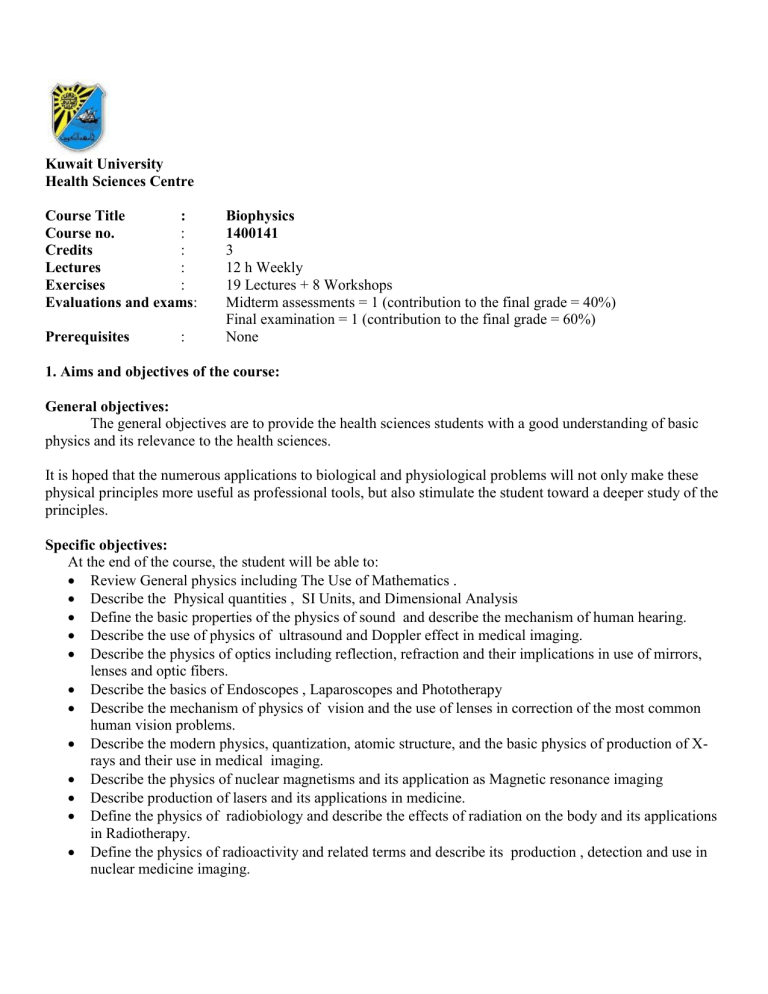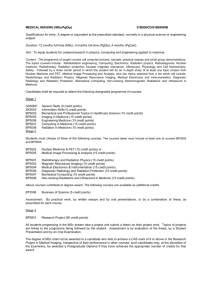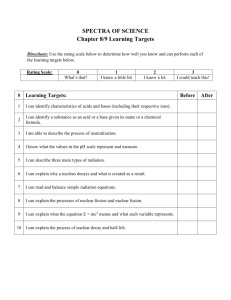Kuwait University Health Sciences Centre Course Title : Biophysics

Kuwait University
Health Sciences Centre
Course Title
Course no.
Credits
Prerequisites
:
:
:
Biophysics
1400141
3
Lectures
Exercises
:
:
12 h Weekly
19 Lectures + 8 Workshops
Evaluations and exams : Midterm assessments = 1 (contribution to the final grade = 40%)
:
Final examination = 1 (contribution to the final grade = 60%)
None
1. Aims and objectives of the course:
General objectives:
The general objectives are to provide the health sciences students with a good understanding of basic physics and its relevance to the health sciences.
It is hoped that the numerous applications to biological and physiological problems will not only make these physical principles more useful as professional tools, but also stimulate the student toward a deeper study of the principles.
Specific objectives:
At the end of the course, the student will be able to:
Review General physics including The Use of Mathematics .
Describe the Physical quantities , SI Units, and Dimensional Analysis
Define the basic properties of the physics of sound and describe the mechanism of human hearing.
Describe the use of physics of ultrasound and Doppler effect in medical imaging.
Describe the physics of optics including reflection, refraction and their implications in use of mirrors, lenses and optic fibers.
Describe the basics of Endoscopes , Laparoscopes and Phototherapy
Describe the mechanism of physics of vision and the use of lenses in correction of the most common human vision problems.
Describe the modern physics, quantization, atomic structure, and the basic physics of production of Xrays and their use in medical imaging.
Describe the physics of nuclear magnetisms and its application as Magnetic resonance imaging
Describe production of lasers and its applications in medicine.
Define the physics of radiobiology and describe the effects of radiation on the body and its applications in Radiotherapy.
Define the physics of radioactivity and related terms and describe its production , detection and use in nuclear medicine imaging.
2. Course contents:
From x-rays to lasers to magnetic resonance imaging , developments in basic physics research have been transformed into medical technologies in imaging, surgery, and therapy at an accelerating pace. In doing its part, physics has joined with genetics and molecular biology to define much of what is modern in modern medicine.
This course introduces important technologies and basic principles relevant to physics for the health sciences students. Readings in a text book for this course, the popular scientific literature, and medical texts will treat both scientific basis and societal implications of Sound physic of Hearing, and Ultrasound imaging ,Optics physics of Vision, and Fiber Optics Endoscopy, Modern Physics of X-ray, Computed Tomography, Magnetic
Resonance imaging, Laser, Nuclear Medicine and Radiotherapy.
That so much of the technology discussed in this course was the stuff of dreams just a few years ago, makes this course as fascinating as it is practical, both for those in medicine as well as those in physics who might one day discover that the project they are working on is basis for the next great medical application.
3. Teaching plan:
1.
Orientation
1.
Introduction
2.
Course goals
3.
Syllabus, policies, dates and grading scales.
4.
Introduce the text, its features, and how it should be used
5.
Use of office hours, tutorials, discussion (or quiz) sections, and the laboratory sections
6.
Short pause for questions or comments from the students.
Hints:
1.
lecture environment is safe by indicating that they are free to ask questions or make comments at any time and that these are welcomed because you prefer the communication be multidirectional
2.
ensure that students have a good understanding of what is required to achieve a given grade in the course
3.
Using a non-traditional lecture approach.
2.
The General physics
1) The Use of Mathematics a.
Scientific Notation and Significant Figures b.
Physical quantities and SI Units :
(i) Relationship between energy and Matter
(ii) Conservation of Energy c.
Dimensional Analysis d.
Problem-Solving Techniques e.
Approximation f.
Graphs
2) Questions and problems
3.
Sound, hearing and Ultrasound
1) Waves a.
The nature of Waves b.
Transverse and Longitudinal Waves c.
Speed of Transverse Waves d.
Periodic Waves e.
Mathematical Description of a Wave f.
Graphing Waves g.
Principle of Superposition h.
Reflection and Refraction i.
Interference and Diffraction
2) Sound j.
Standing Waves a.
Sound Waves b.
The Speed of Sound Waves c.
Amplitude and Intensity of Sound Waves d.
Decibels
3) Physics of hearing a.
Range and Sensitivity of Human Hearing b.
The Decibels scale c.
Threshold of hearing and pain d.
Applications of sound in Medicine : The Human Ear
4) Ultrasonic Sound a.
Reflection and acoustic impedance b.
Attenuation of ultrasound waves and its effect c.
Generation and detection of ultrasound waves d.
The Doppler Effect e.
Applications of sound in Medicine : Medical US Imaging
5) Questions and problems
4.
Echolocation and Medical Imaging
5.
Optics I
1) Reflection and Refraction of Light a.
Wave fronts, Rays, and Huygens’s Principle b.
The Reflection of Light c.
The Refraction of Light: Snell’s Law d.
Total Internal Reflection a.
Fiber optics b.
Medical applications : Endoscope, Laparoscope and Phototherapy
2) Questions and problems
6.
Optics II
1) Thin Lenses a.
The Formation of Images by Lenses b.
The Thin-Lens Equation and the Magnification Equation
2) The Physics of Vision a.
The Human Eye b.
Formation of images by the Eye c.
Angular Magnification and Magnifying Glass d.
Medical applications : Common Vision Defects
3) Questions and problems
7.
Electromagnetic Radiation
1.
Electromagnetic Radiation a.
Wave Behavior b.
Accelerating Charges Produce Electromagnetic Waves c.
Maxwell’s Equations d.
Antennas e.
EM Waves Properties f.
The Electromagnetic Spectrum g.
Speed of EM Waves in Vacuum and in Matter h.
Characteristics of Electromagnetic Waves in Vacuum i.
EM Radiation Production j.
EM Radiation Range k.
EM Radiation: Medical Application l.
EM Radiation: Quantization
8.
Modern Physics I:
1.
Particles and Waves a.
The wave – Particle Duality b.
Blackbody Radiation and Planck’s constant c.
Photons and Photoelectric Effect d.
The Momentum of the Photon and Compton Effect e.
The Broglie Wavelength and the Wave Nature of Matter f.
Medical Application : The Electron Microscope
9.
Modern Physics II:
1.
The Nature of the atom a.
Early Models of the Atom b.
The Bohr Model of the Hydrogen Atom
2.
The X-Rays a.
Introduction b.
X – Rays Production c.
X-Ray Tubes d.
Characteristic radiation e.
Bremsstrahlung radiation f.
Factors affecting X-Ray Emission g.
Medical application : Diagnostic X-Ray and CAT scan
3.
Questions and problems
10.
The Clinical applications: X-rays and CT
11.
Modern Physics II:
1.
Quantum Mechanics – A new Theory a.
The Quantum Mechanical Picture of the Hydrogen Atom b.
Energy Level Diagrams, Excitation and Ionization c.
The Pauli exclusion principle a.
Lasers
(i) Basic Physics of Laser
(ii) Laser Properties
(iii)The Helium – Neon Model
(iv) The Ruby Laser
(v) Other Lasers
(vi) Medical applications : Laser surgery on the Eye and in Dermatology
2.
Questions and problems
12. Clinical applications of Laser
13.
The Physics of Nuclear Magnetic Resonance
1.
Basic Physics a.
The science of magnetism b.
Nuclear magnetism c.
Tissue Magnetization d.
Precession and Larmor frequency e.
Resonance f.
Relaxation g.
T1 recovery and T2 recovery h.
Echo and Repetition Times i.
Image contrast j.
Medical applications
2.
Questions and problems
14.
Clinical application of
Nuclear Magnetic Resonance
15.
Nuclear physics I
1.
Nuclear Physics and Radioactivity a.
Structure and properties of the nucleus b.
The Strong Nuclear Force and the Stability of the Nucleus c.
The mass Defect of the Nucleus and Nuclear Binding Energy d.
Radioactivity e.
Conservation Laws in Radioactive Decay f.
Modes of Radioactive Decays g.
Radioactive decay and Half-lives
2.
Questions and problems
16.
Nuclear physics II
1.
Radiation Detection a.
Interaction of nuclear radiation with matter b.
Charged Particles and Photon Interactions c.
Attenuation of Photons d.
Detection of nuclear radiation e.
Types of Instruments f.
The Gamma Camera g.
Medical Applications : Nuclear Medicine Imaging
2.
Questions and problems
17.
Clinical Applications of Nuclear Medicine
18.
Ionizing Radiation and Nuclear Energy;
1.
Nuclear Energy ; Effects and Uses of Radiation a.
Passage of Radiation Through Matter b.
Effects of Radiations c.
Radiation Units : Exposure, Absorption and Dose Equivalent. d.
Medical Applications : Radiotherapy
2.
Questions and problems
19.
Clinical application of Radiotherapy
3.
Textbooks and Reading Materials:
Amador S. Physics in Modern Medicine. 2003
Additional Readings
Nave and Nave: Physics for the health sciences 3rd edition
Cutnell&Johnson: Physics ( 7TH Edition)
Giambattista, Richardson and Richardson: College Physics (2nd. Edition)
2007
Course Director: Dr. Gaber Ziada; BSc, MSc & PhD
Nuclear Medicine Division
drgziada@hsc.edu.kw
4.
Teaching Tools
Lectures using computer presentations
Workshops (Tutorials, Experiments and Demos)
Well prepared and fine finished lecture Handouts
Guided student-based learning
.1.
HSC home page ; e-learning ; Biophysics course
.2.
(ARIS): www.mhhe.com/grr Course section code FAD-E3-64B (( Mc Graw Hill – Higher
Education ))
Problem-based learning
Useful links to internet sites
Search using internet and library resources






